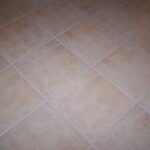Having owned a home, I learned that there are a lot of things you can do to improve the appearance of your home, and how to paint over tile was one of those things I learned. It’s relatively simple and easy, you just have to be patient and take your time, and you can end up with tile that looks like it was just installed.
Before we begin however, I would like to go over a few points with you. The procedure I will be giving is based on tile used for your back-splash or even tile inside your bathrooms, as long as it isn’t the tile surrounding your bathtub or shower.
When I was learning how to paint tiles, the person at Home Depot instructed me to never try painting tiles in those areas. That they should be done professionally, by someone that knows how to do the job properly, using better equipment, materials and a process that is guaranteed to keep the paint on the tile in those areas.
They said the process you use on your back-splash is not enough for those areas, and that if you were to do it yourself, the paint would probably start coming up in a few days anyway. This is because that tile is constantly being exposed to water, and water will make the paint you apply, come up.
So the painting tiles process I’m going to give you is for any area that is not going to be exposed to water. Let me give you the simple list of materials you will need first…
Materials Needed For Painting Tiles:
– Sander (optional)
– 220 grit sandpaper
– 1/8 inch nap paint roller
– 1 inch natural fiber brush
– Can of oil based paint (semi-gloss or high-gloss)
– Can of oil based primer (high quality)
– Lots of rags
– Cleaning solvent
Prepping Tiles For Paint:
You need to know that just spreading on a layer of paint isn’t going to work. Paint isn’t going to stick to your tile as it is now, because paint will not stick to shiny, slick surfaces. You need to prepare the tile surface so your paint will adhere to it.
The first thing you need to do is clean the tile thoroughly. Get rid of any and all dirt, grime, grease, mold, mildew, cracked grout, dirty and dingy grout and grout that might be missing. All this has to be cleaned and repaired before you can start to paint.
If you try to paint over this, your paint will not adhere to those spots, and it will probably show through your paint anyway. So take care of these problem areas before you paint.
When your tile is thoroughly clean, take either your sander with the 220 grit sandpaper and begin sanding the tile, or if you prefer, you can do this by hand. The only difference between the two, is time. But the point is to sand the surface to get rid of the shine and the slickness of the tile.
You want to roughen up the surface, just be careful you don’t make any lines that may show through your paint. The 220 sandpaper is rough enough to remove the shine, but gentle enough not to gouge into the surface. Make sure you do a good job of sanding, and don’t forget the corners. They are a little hard to get into, but they must be done.
When you have completed sanding the surface of the tiles, cleaned and removed all the tile dust, then you can begin the next step.
How To Prime And Paint Tiles:
The next step is to prime the tile before you paint it. When you paint over tile, you need to create a good foundation for your paint to adhere to, so you really need to prime first. You should also consider using a very good high quality primer. In this case, it’s true, you get what you pay for.
Using a good oil based primer will guarantee that your tiles look the same two years from now, as they will look when you finish painting them. So get yourself a good primer. I suggest an oil based primer, because the paint is oil based, and even though oil based is hard to clean up, the end product is worth it.
The natural bristle 1″ paint brush should be the type that can be used with oil based paint or varnish. They do an excellent job of painting, and you will need to use this brush to paint the corners of your tiles.
So start painting in the corners, then use the 1/8″ nap roller to finish on the rest of the tile. When painting tile, make sure you don’t leave any ridges or lines with your roller brush. These should all be smoothed out. That will prevent them from showing under your paint.
The first layer is just going to be a thin layer. Don’t try to put a thick layer of primer on at one time and then start to paint. Instead, you want to put several thin layers of primer on your tiles. Build the layers up to give yourself a good painting foundation, and something that will last.
Let each layer dry before applying the next. About 2 or 3 thin layers should be enough. When you have completed priming the tile, and it is completely dry, now it’s time to sand again. You aren’t going to sand the way you sanded when you were preparing the tile for the primer. All you’re doing is going over the primer very gently to make sure any ridges, lines, bumps and burrs are removed before you paint.
Remember, if they are not removed before you start painting, these imperfections will show through your paint. Once you have sanded the tile again, be sure to remove and clean all the dust before you start painting tiles.
Once the wall is clean, you can begin painting. Clean your brush and roller in the cleaning solvent and use them for painting. Again, apply several thin coats at a time. I know it takes a while for oil based paint to dry, but applying several layers builds the paint up and gives your tile better protection.
Two or three layers will be plenty, and when the paint dries, your tile will look brand new. I suggested using an oil based paint simply because I think they are better for this type of project. Latex paints are nice and they are easy to clean and easy to dry, but they are also easy to chip and peel away.
This isn’t something you want happening to your freshly painted tile. If you put the time, energy and money into this project, you want it to last. So spend a little extra and get a high quality oil based primer and an oil based paint and you won’t go wrong.
That’s it! You’ve completed the task of painting tiles. It’s easy, and the only hard thing is cleaning your paint brush and roller. So now you know how simple it is to paint over tile. If you think this is something you want to do, then go get your materials and get started.
The major points to remember is to thoroughly clean and repair the tile and grout, sand to remove the shiny and slick surface, apply several layers of high quality oil based primer, sand lightly to remove lines, ridges and burrs, then apply several layers of oil based paint, wait until it dries and you end up with beautiful, clean tile that looks like it has just been installed.
Good luck, and thank you for reading How to Paint Over Tile. I hope this has been of some help to you. Good painting!



